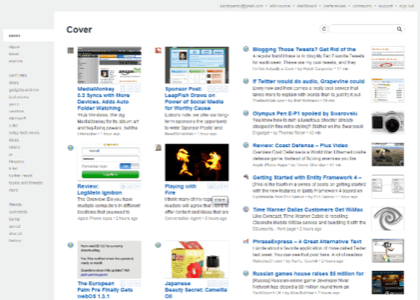Feedly, the magazine style feed reader we first covered back in August of last year, is now available for the Google Chrome web browser. As with the Firefox implementation of the service, the Chrome version also uses a browser plugin to offer an alternative user interface to Google Reader. This early version of the Feedly for Chrome release offers most of the features found in the original Firefox version of the service, but requires the installation of a dev build of Chrome in order to work.

Feedly: A Better RSS Reader and More
Feedly is much more than just another way to read feeds. Although it originally got its start as an alternative UI to Google Reader, today the service is part RSS reader, part social network aggregator and part search utility. Since its launch in 2008, Feedly’s developer Edwin Khodabakchian has constantly added new features including Twitter and FriendFeed integrations, a river of news view, search tools, Mozilla Ubiquity integration, a Feedly “mini” toolbar and so much more.
Once installed, a click of a browser button transports you to the Feedly start page where you can browse through the latest news, comment, star, share, discuss and search through the articles displayed. As you read through the items, your activity is seamlessly synced back to Google Reader.
Although voracious RSS readers who subscribe to thousands of feeds may find using Feedly a bit slower than using Google Reader itself, a good many of the more casual consumers of RSS prefer Feedly’s clean, easy-to-scan interface to Google Reader’s more utilitarian look and feel.
Feedly for Chrome
The new Chrome version of Feedly is virtually identical to the one available for Firefox with only two major exceptions: there is no Gmail integration or Feedly mini toolbar available in the Chrome version just yet. The toolbar is one of Feedly’s many innovative features which provides a floating bar that hovers at the bottom of your screen as you surf through blogs on the web. Toolbar buttons show you various pieces of metadata about the blog post you’re reading, including number of Diggs and number of Google Reader shares. You can also save or share the post yourself in Google Reader or tweet a link to the article, among other things.

However, according to Khodabakchian, Feedly mini’s omission isn’t due to any technical issues. Instead, he notes in the comments of a Feedly blog post that the mini toolbar is in the process of being redesigned and when the Firefox version is complete and stable, he will then look into building a toolbar for Chrome. The estimated timeframe for its inclusion into the Chrome beta is 6-8 weeks.
How to Install Feedly for Chrome
In order to run Feedly for Chrome, you’ll need to first install a dev build of the Google Chrome browser. These dev (“developer”) versions of Chrome aren’t as stable as the public release but allow you to play with yet-to-launch features like Google Chrome extensions, for example. And for Mac and Linux users, the dev release is your only option because Google has yet to provide stable versions of Chrome for those two operating systems as of yet.
After installing the dev release, you’ll need to add the new Feedly extension to the browser.
Here’s how to get started:
- Download and install the Chrome 4.0 Dev Channel: Windows | Mac | Linux 32-bit | Linux 64-bit
- Restart Chrome to make sure that you are running the 4.0 version.
- Load http://update.feedly.com/release/feedly.crx to install Feedly.
- Click on the Feedly icon on the chrome toolbar to load your Feedly.
After you have Feedly up-and-running, you can receive support through the company’s Get Satisfaction page or by emailing feedly-chrome AT devhd.com. You can also tweet @feedly_chrome with questions, comments, and other feedback.
We’re beyond excited to see Feedly on Chrome – although it was relatively easy to give up most of our Firefox extensions when we made the move to the Chrome browser, Feedly was one of the few that was sorely missed. However, if you’re a more cautious user hesitant to install test builds of your browser and experimental extensions, you may not have to wait much longer before you can play with fully functional and stable versions of both. Yesterday, Google put out the call for developers to begin submitting their extensions for inclusion in the upcoming Chrome extension gallery, a step that signifies that this feature is closer than ever to launching. When the time comes, we’re sure that Feedly will be among the top-rated extensions found there.










